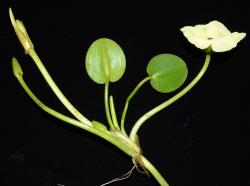Perennial, glabrous aquatic herbs, with leaves proliferating from stolons. Roots fibrous, non-septate. Hermaphrodite. Leaves floating, emergent or submersed from a rosette; floating leaves long petiolate, leaf-bases cordate; submersed phyllodia non-petiolate, ribbon-like. Inflorescence a scape, bracteate. Flowers perfect, long pedicellate. Androecium 6–many stamens in whorls, the outer often sterile; filaments linear, flattened, glabrous; anthers basifixed, extrorse dehiscence; staminodes present. Gynoecium 3–8 with proximally coherent carpels attenuate to a curved terminal style; ovule placentation laminar, many per carpel. Fruit a follicle, more or less terete, dehiscing along the inner margin, beaked, without wings. Seeds uncinate with stalked, glandular hairs.
The genus Hydrocleys was treated in the family Butomaceae by Healy & Edgar (1980) and in the Limnocharitaceae by recent floras (Haynes & Holm-Neilsen 1992, Jacobs & McColl 2011), but is here included in the Alismataceae (Les & Tippery 2013). The three genera of the Limnocharitaceae, Butomopsis, Hydrocleys and Limnocharis, share with Alismataceae s.s., milky sap, petiolate leaves with a terminal pore, a sepaloid calyx, thin and delicate petals that are crumpled in bud, and curved seeds and embryos (Haynes & Holm-Neilsen 1992).
Hydrocleys is easily distinguished from other genera in the Alismataceae, as species have relatively large, yellow (New Zealand) or white flowers on lax peduncles, and a mostly floating leaf habit rather than an erect, emergent habit. The leaves are round to oval in shape on long petioles, which, along with the pedicels, are conspicuously septate. The seed is released from relatively large, dehiscing follicles rather than indehiscent achenes, and the seeds have conspicuous, stalked, glandular hairs.
Five species in tropical and subtropical America, from Jamaica to southern Mexico and El Salvador, south to Bolivia and northeastern Argentina.
| Category | Number |
|---|---|
| Exotic: Fully Naturalised | 1 |
| Total | 1 |
n = 8 is regarded as basic (Rao 1953, Haynes & Holm-Neilsen 1992), n = 7 is hypothesised to have arisen through a Robertsonian translocation (Kenton 1981).
Healy & Edgar (1980) treated one species of Hydrocleys in New Zealand, H. nymphoides. No additional species are reported here.




